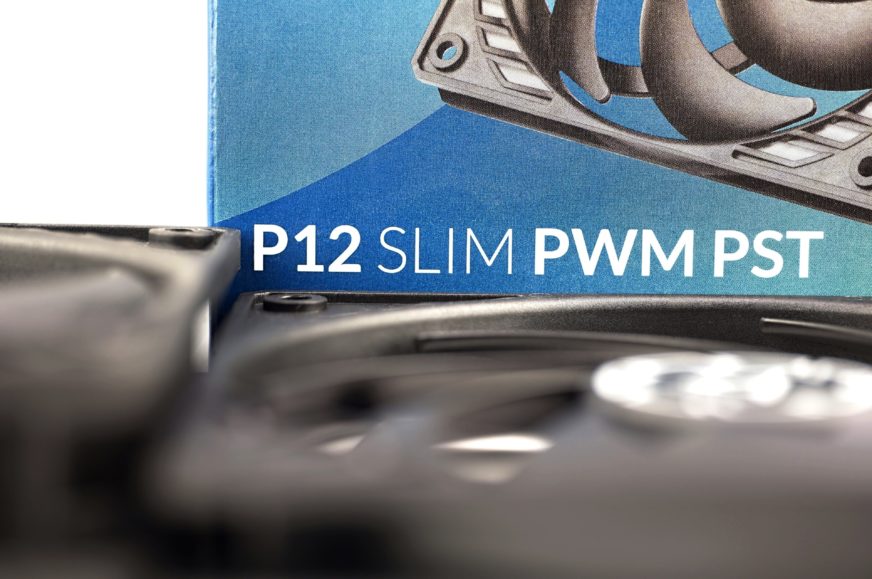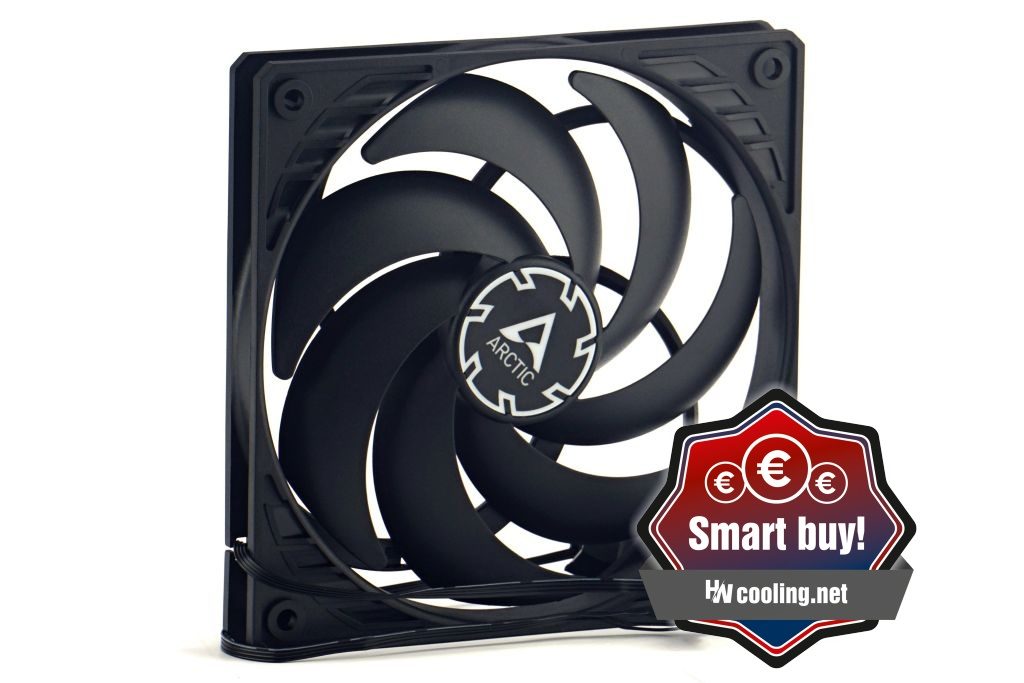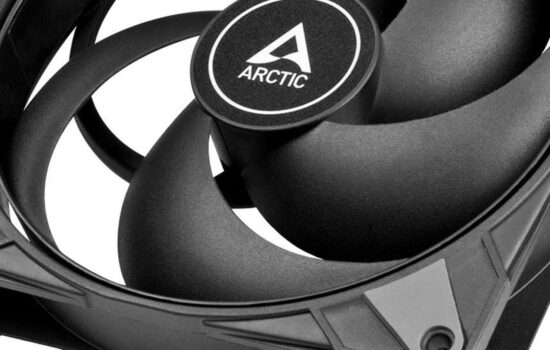Evaluation
Low-profile fans are often seen as compromise solutions that will not achieve the efficiency of thicker models. This may or may not be true. In practice, the Arctic P12 Slim beats a number of full-size fans. Sure, Arctic’s 15mm fan has many shortcomings, but these are vindicated by the very low price. In the 120mm format, it is one of the cheapest, but definitely not the “weakest” slim fans.
Evaluation
In a no-obstacle environment, the results of the Arctic P12 Slim PWM PST fan are rather unimpressive. Efficiency (the ratio of achieved airflow to noise is well below average), at higher speeds ends up in the penultimate positions.
Positioning is higher with lower RPMs, but it’s only really attractive in obstacle applications. Naturally, the airflow is even lower, but the drop is smaller than, say, the competing Alphacool SL-15 PWM fan. As a result, the Arctic fan outperforms not only it, but also many models with a 25 mm thick profile. There are also impressive results on the nylon filter, but it still presents a rather non-restrictive environment.
The Arctic P12 Slim fares even better on a plastic filter, on which there is already quite a big jump (to the plus side) at medium and lower speeds (i.e. practical for these applications) even from a fan such as the Noctua NF-P12 redux-1700 PWM. The Arctic P12 Slim PWM PST wins across all noise levels on a hexagonal grille as well. At the lowest noise level, at very low speeds (~680rpm), Arctic’s slim fan here leaves even the 140mm Gigabyte Aorus RGB behind.
In general, we can say that the P12 Slim lags behind such thicker fans that use shorter blades with a smaller radius of curvature of the leading edges. These tend to be noisier just because of the shape of the airflow, which strikes the frame more, where there is more friction, more microturbulence, and overall noisier operation. In tests standardised to the equal noise levels, but also in practice, these designs are thus naturally at a disadvantage.
In the midst of the performance spectrum of other fans, the Arctic P12 Slim PWM PST also holds its own on radiators as well, which is excellent considering the format (120/15mm). And again, the lower the speed the better this fan performs. The exception is, of course, critical speeds with aggressive resonant sound frequencies. You should avoid speeds around 850 rpm, which are very uncomfortable in this regard.
The more pronounced peaks (around 380 Hz, but also the more rumbly 155 Hz) can never be completely avoided, but that’s the toll of the long and flexible blades. You’ll at least take solace in the fact that the frame doesn’t receive such intense vibrations as with the Arctic BioniX P120 A-RGB. This is probably also because the P12 Slim rotor is significantly lighter and exerts less force. From about 1120 rpm upwards, no vibrations were detected anymore. Some negligible ones are certainly still there, but of such low intensity that they are below the resolution of our measuring apparatus. And know that it really doesn’t lack sensitivity.
The power of the motor is quite low (barely 1.9 W), but it’s enough to compensate for the very high resistance of the environment (and the rotor doesn’t slow down too much in it). However, over time (use) some of the energy will be needed for increased friction at bearing level, which may be worse – the fan has no reserves whatsoever. Arctic doesn’t state a mean time between failures, but the fan is covered by up to a 10-year warranty, so hopefully it will last a while after all.
For the price of only 7 EUR, it is in any case a great fan, which has an extremely favourable price/performance ratio within its category. This is also indicated by the coefficient of airflow per euro, although this is based “only” on measurements without obstacles. And you already know that in practice, on obstacles, the Arctic P12 Slim PWM PST is even more attractive compared to other fans.
English translation and edit by Jozef Dudáš
| Arctic P12 Slim PWM PST |
| + Suitable for use case |
| + Extremely low price |
| + Superb compatibility for lowered profile |
| + Top-notch price/cooling performance ratio |
| + Cooling efficiency (airflow/pressure per unit of noise) at a very high level |
| + Beats even many 120 mm fans with a typical thickness of 25 mm |
| + High airflow and static pressure even through a restrictive obstacle |
| + Wide speed range |
| + Really low speeds possible (stable from approx. 257 rpm) |
| + Very quiet operation of bearings and motor |
| + Negligible vibrations at lower speeds |
| - More flexible rotor... |
| - ... with frequent resonant frequencies around (humming) 380 and (rumbling) 155 Hz |
| - Lower motor power – less margin for natural wear |
| Approximate retail price: 7 EUR |
I1&&0*agDq34#Mnh
- Contents
- Arctic P12 Slim PWM PST in detail
- Basis of the methodology, the wind tunnel
- Mounting and vibration measurement
- Initial warm-up and speed recording
- Base 6 equal noise levels…
- ... and sound color (frequency characteristic)
- Static pressure measurement…
- … and airflow
- Everything changes with obstacles
- How we measure power draw and motor power
- Measuring the intensity (and power draw) of lighting
- Results: Speed
- Results: Airlow w/o obstacles
- Results: Airflow through a nylon filter
- Results: Airflow through a plastic filter
- Results: Airflow through a hexagonal grille
- Results: Airflow through a thinner radiator
- Results: Airflow through a thicker radiator
- Results: Static pressure w/o obstacles
- Results: Static pressure through a nylon filter
- Results: Static pressure through a plastic filter
- Results: Static pressure through a hexagonal grille
- Results: Static pressure through a thinner radiator
- Results: Static pressure through a thicker radiator
- Results: Static pressure, efficiency by orientation
- Reality vs. specifications
- Results: Frequency response of sound w/o obstacles
- Results: Frequency response of sound with a dust filter
- Results: Frequency response of sound with a hexagonal grille
- Results: Frequency response of sound with a radiator
- Results: Vibration, in total (3D vector length)
- Results: Vibration, X-axis
- Results: Vibration, Y-axis
- Results: Vibration, Z-axis
- Results: Power draw (and motor power)
- Results: Cooling performance per watt, airflow
- Results: Cooling performance per watt, static pressure
- Airflow per euro
- Static pressure per euro
- Results: Lighting – LED luminance and power draw
- Results: LED to motor power draw ratio
- Evaluation












